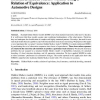Free Online Productivity Tools
i2Speak
i2Symbol
i2OCR
iTex2Img
iWeb2Print
iWeb2Shot
i2Type
iPdf2Split
iPdf2Merge
i2Bopomofo
i2Arabic
i2Style
i2Image
i2PDF
iLatex2Rtf
Sci2ools
DATAMINE
2006
2006
Structural Hidden Markov Models Using a Relation of Equivalence: Application to Automotive Designs
Standard hidden Markov models (HMM's) have been studied extensively in the last two decades. It is well known that these models assume state conditional independence of the observations. Therefore, they are inadequate for classification of complex and highly structured patterns. Nowadays, the need for new statistical models that are capable to cope with structural time series data is increasing. We propose in this paper a novel paradigm that we named "structural hidden Markov model" (SHMM). It extends traditional HMM's by partitioning the set of observation sequences into classes of equivalences. These observation sequences are related in the sense they all contribute to produce a particular local structure. We describe four basic problems that are assigned to a structural hidden Markov model: (1) probability evaluation, (2) statistical decoding, (3) local structure decoding, and (4) parameter estimation. We have applied SHMM in order to mine customers' prefere...
| Added | 11 Dec 2010 |
| Updated | 11 Dec 2010 |
| Type | Journal |
| Year | 2006 |
| Where | DATAMINE |
| Authors | Djamel Bouchaffra, Jun Tan |
Comments (0)

